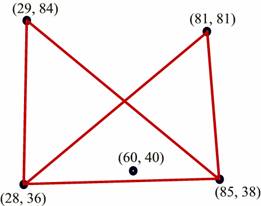|
A |
Strange
Tax Calculation Input: Standard Input Output: Standard Output |
The people living in large cities have to pay more tax than people living in rural areas. That is because in cities people have many facilities, which rural people donít have. Also people in large and famous cities tend to pay more tax than people living in smaller cities or towns. Government of Euphoria now has a strange rule to decide tax rate Ė Tax rate of a house is proportional to the total number of houses within 1 kilometer radius of it. The rule apparently seems ok, but as a result people have started building houses 500 meters away from the main city and in this way they are enjoying all the facilities but paying much less taxes. Also in this way the town has begun to expand very quickly, which is not desirable.
So the government of Euphoria now
decides to make a new tax rule which will be less (or not) understood by common
people and hence it will have less chance of being manipulated. In the new
rule, tax depends on the number of high rise buildings in the city and their
orientation. Any three high rise building makes Bermuda block in the city and
the tax depends on average number of high rise buildings per
|
|
|
|
Figure 1: High-rise buildings of Euphoria |
Figure 2: The black circles
denote the locations of high-rise buildings. Of the 10 |
As total number of buildings can be high so you have to help the Mayor of Euphoria to write an efficient program that will help calculate tax.
Input
The input file contains several sets of inputs.
Each set starts with an integer N (0 ≤ N ≤ 1200), which denotes the total number of high rise building in the city. Each of the next N lines contains two integers xi, yi (0 ≤ xi, yi ≤ 10000) which actually denotes that the Cartesian coordinate of the i-th high-rise building is (xi, yi). You can assume that the city is located on a flat land and it is so large that a point can actually be used to denote the position of a high-rise building. You can also assume that no three buildings are on the same straight line and no two buildings are at the same place either.
Input is terminated by a case where N=0.
Output
For each set
of input produce one line of output. This line contains the serial of output
followed by a floating-point number. This floating-point number denotes the
average number of high rise buildings per
Sample Input††††††††††††††††††††††††††† Output for Sample
Input
|
5 29 84 81 81 28 36 60 40 85 38 5 0 0 10 0 0 10 10 10 6 7 0 |
City 1: 0.20 City 2: 0.20 |
Problemsetter: Shahriar Manzoor
Special Thanks: Derek Kisman

